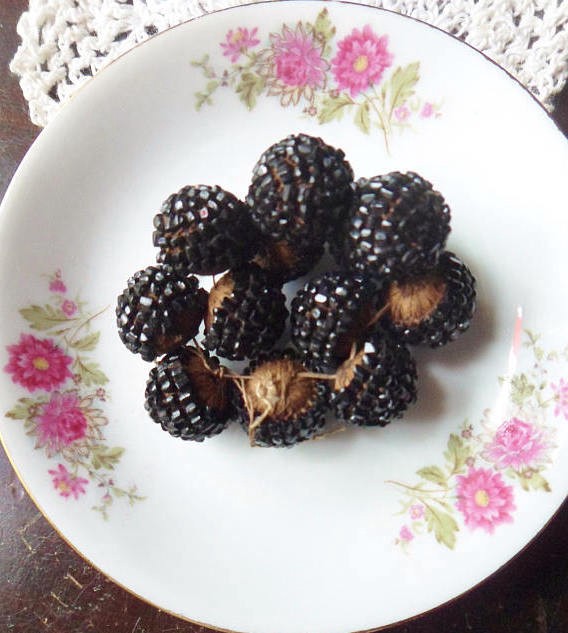Books & Culture
Laura Ingalls Wilder’s Magical Objects
On the pleasure and longing associated with storied possessions

The cup, the gun, the doll, the cape, the button box and the scrap bag, the stick of candy savored and then gone, the carved shelf, the china shepherdess, the fiddle and its song, the story, the dress with blackberry buttons, the golden pin and the engagement ring, the new stove, the red mittens, the willow rocker, the string of Indian beads, the blue coat lined with swan skin, the butter churn and butter mold, the bullet mold and molten lead, the cow, the horses, the geese, the chickens, the kitten, the hand-knit lace, the shiny penny, the hay stick, the coffee grinder, the covered wagon, the sunbonnet swung by its strings.
If you have read the Little House books, you recognize these things, the practical objects and the magical ones. Perhaps you, too, have coveted them, bought replicas in a gift shop, scoured Ebay, antique stores, and rummage sales for items like Carrie’s china dog, Laura’s glass box, or Ma’s thimble, then felt the connection spooling through the object straight home to the Little House. Perhaps like one historical archeologist, you have even allowed Laura’s “detailed, loving references to the family’s stuff” determine your choice of a career.

When I first read these books, I loved the practical objects and the activities they engendered. I wanted to churn butter and make my own rag doll, see a bullet made at an open hearth, prize new woolen mittens as a Christmas gift, rejoice as Laura did in receiving my very own tin cup for the very first time. I wanted to wrap myself in woolen veils to keep warm and wear layers of petticoats trimmed with lace I’d made myself. I wanted to grind wheat into flour and then bake it into bread, to dance to a fiddle tune. And I did do some of these things —baked rugelach with my grandmother Bertha, whose story of emigration from eastern Europe had always fascinated me, learned to knit, make jam, and square dance, sewed patches on my jeans if not the jeans themselves — as I searched for a more direct connection between what I consumed and what I produced, romanticized and idealized though that connection may have been. It was the 1970s, and even for a Manhattan teenager, the back-to-the-land movement had an allure.
I wanted to grind wheat into flour and then bake it into bread, to dance to a fiddle tune. It was the 1970s, and even for a Manhattan teenager, the back-to-the-land movement had an allure.
I longed for the pretty decorative things too — a golden bar pin etched with a little house, the gilt braid along the edge of a dark blue flannel dress, beads collected at an Indian camp and tied up in the corner of a handkerchief, Laura’s engagement ring and her oval glass bread plate saved from fire. I did not long for a single penny as Laura did, but I longed to long for one, longed to feel that in scarcity anything small and shiny would take on a special gleam.
Even the lovely and useless things were not magical, though. The magical things were so pleasurable that they could never be forgotten, so powerful and terrible that they could never be touched. Only these special objects magnetized my eyes. In Constructing the Little House: Gender, Culture, and Laura Ingalls Wilder, Ann Romines has called Laura’s longing for these objects a “transcendent desire.” The blackberry buttons on Aunt Docia’s dress, juicy enough to eat, the knick-knack shelf of vines, flowers, and stars carved by Pa, the china shepherdess always placed on that shelf, and Ma’s fine silk and wool delaine dress transported me, too: the object itself and the desire for that object coalesced into a tunnel or doorway or portkey and pulling me physically into the world of the books. These things are weighty — as Romine says, “heavy with stories.”

When Aunt Docia reappears, Laura recognizes her through the memory of those buttons, time-traveling back to the sugaring-off dance where she first saw and craved them. These magical objects push us, pull us, even as they command stillness and demand silence, a hand outstretched. Only Ma can touch the shepherdess. If Baby Carrie clutches her, she may shatter. If Laura tastes those blackberry buttons, she will find only jet or glass. (So long in mourning, Queen Victoria introduced the fashion of carved jet buttons; poorer folk would have mimicked her style with black glass). The knick-knack shelf’s carved vines, moon, and stars are traced by eye, not hand, and even Ma could be transformed into something “so rich and fine that Laura was afraid to touch her.”
I did not long for a single penny as Laura did, but I longed to long for one, longed to feel that in scarcity anything small and shiny would take on a special gleam.
The china shepherdess, most iconic of these iconic things, has a cameo in every book, described the same way each time — or nearly so, as if the hand of memory is turning the little figurine this way and that, as if narrator-Laura is saying “Oh yes, there were skirts,” then later, “Oh yes, the skirts were wide.” At first she’s a little china woman and then a little china shepherdess. At first she wears a china bonnet over her china curls. Her bonnet is never mentioned again, but her hair is often described — how it’s golden, how it’s curled. Her apron is pink right away; later, her cheeks are too. Her dress is laced across in front, and later those bodice laces tighten. Her little shoes are always gilt, but only later are her eyes called blue. Although Laura claims that the china shepherdess is always the same, smiling the same smile, her eyes as sweet as ever, her hair as bright as it was so long ago in the Big Woods, she changes and shifts in subtle ways. So static and solid, even so, she shimmers.

Through seven books, from the moment Pa places her upon the carved shelf in Little House in the Big Woods to the moment in These Happy Golden Years when Ma says their home is no longer a claim shanty but a real, four-room house, the china shepherdess is “the weird secret Ingalls signal that a house had become a home.” She gets packed away safely and taken out again when they have stopped moving, if only temporarily, and Ma has decided that they are no longer savages. She’s placed on the log cabin mantel in Indian Territory, in the board house Pa builds near Plum Creek, and finally in the claim-shanty-turned-farmhouse at Silver Lake but tellingly not in the Surveyor’s house which the family is only borrowing for the winter nor in the dugout where the family lives like muskrats rather than human beings, although Ma and the girls do their best to keep that earthen floor clean.
Out of the Woods: Appalachia, Literature, and the American Dream
As Romines says, the shepherdess and the good dress, like the church newspapers she treasures, signify Ma’s hopes that her girls will grow up to be ladies, her belief in order and in God, and a lasting connection between her family and the whole civilized world she left behind when she followed Pa westward. I understand this, but for me, the china shepherdess and the blackberry buttons are not allegorical objects but magical ones (perhaps other Laura objects are magical for you). They serve no concrete purpose nor symbolic one. Instead, they are pure fascination and enchantment. Their force fields both attract and repel.

I find an image of blackberry buttons online, hoping to buy them although I’ll never sew them to a sweater or dress, but it turns out they’re dark red rather than black, plastic rather than glass. I learn about fine delaine cloth, and the probable make of Pa’s violin although I do not play. While the location of the original china shepherdess remains a mystery, one contender has turned up among Carrie’s belongings. Hurriedly I search for images of it on display in the Keystone South Dakota Historical Society, only to be disappointed as many others have been: photos show a faded little figure in gilt shoes and breeches, more courtier than shepherdess. A replica, available through the gift shop in DeSmet, is equally disappointing, despite the fact that it looks almost exactly as described in the books — perhaps because I know it’s not “the one.” This research is a grasping hand, but when it finally finds the objects, it turns out their magic depends on a constantly teasing desire that, once fulfilled, dissolves, like candy on the tongue. (Oh, how the Ingalls girls knew that saving their Christmas candy, parceling it out, would make it sweeter; oh, how they still couldn’t stop themselves from devouring it all at once. Ma knew something similar, parceling out those magazine stories to be read during the long winter.) And so I leave the ersatz objects behind and return to Laura’s words and images, objects themselves, their intense physicality, their magical aura.
A replica, available through the gift shop in DeSmet, is equally disappointing, despite the fact that it looks almost exactly as described in the books — perhaps because I know it’s not “the one.”
From my grandmother Bertha I mostly inherited costume jewelry — multi-colored clip-on earrings and gigantic cut glass brooches — and also a disintegrating wallet containing expired charge cards from Saks and Gimbels, postcards I’d sent her from my summer vacations, a bill for the upkeep of my grandfather’s grave. Only her shiny brass samovar was intriguing, the one thing that remained from her childhood in Russia. Its tall fluted urn sat in her home and then in my parents’. Dusting it, I marveled at the scrolled handles and spout, the chimney on which to warm the tea pot. I imagined my ancestors sipping tea through a sugar cube held between their teeth or drinking tea into which a spoonful of jam had been stirred, a foreign and glamorous custom.
After my parents both died, the samovar finally came to me, but in the years since, I have not unpacked it, despite its fairy tale promise, fearing that when I open the box and remove the crumpled newspaper, I will find only tarnished metal. No time machine, no repository of stories flowing as freely as hot water used to flow from its spout. I suspect that touching it will not magically allow me to remember more about Bertha or improve the memories of the two elderly women still alive who actually knew her.
Family stories leak into the world: instruction, entertainment, warning, history, savior, and sanctuary. Treasured and preserved, returned to again and again, they can themselves become magical objects.
Family stories leak into the world: instruction, entertainment, warning, history, savior, and sanctuary. Treasured and preserved, returned to again and again, they can themselves become magical objects. The Ingalls girls valued Pa’s tales so highly that the very last thing Baby Sister Grace did before Mary went off to The College for the Blind was beg to sit in her lap and hear the story of Grandpa and the panther one last time. Laura loved Pa’s fiddle tunes, and he ceremoniously left this instrument to her even though she didn’t play, but when he was gone, she missed the music, not the instrument. His stories about bears and panthers, about naughty children trying to escape the confines of a Sunday afternoon, and perhaps about Laura’s own childhood were never forgotten, she said, and “to[o] good to be altogether lost,” the most important inheritance.
The stories about my grandmother have themselves become talismanic, inscribed on my heart. They have taken on the apocryphal nature of the stories about saints. How she was a runner for the failed 1905 Communist revolution in Belarus. How she listened at the window to learn her brothers’ lessons and yearned for an education. How she came to America, alone, when she was twelve. How she escaped the Triangle Fire and started a union. I turn to these stories in times of distress, as if repeating them will bring good luck or strength, fortitude or vision; her actions serve as omen or oracle; the retelling of tales, an incantation.










